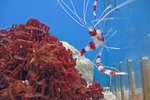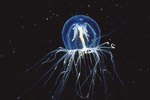
Although small, shrimp are vital to marine and freshwater life and are important food sources for a variety of animals ranging from small fish to whales and turtles to toads. Shrimp are also the cleanup crew for the water, whether in the wild or in an aquarium, scavenging the surface for bits of plant and animal matter.
Shrimp Legs
Shrimp have eight pairs of legs that are found within both sections of the body. The first three pairs are the feeding legs -- the maxillipeds -- which are found on the abdomen of the shrimp. The other five pairs are the pereopods -- the walking legs -- which are found on the cephalothorax of the shrimp. In some species of shrimp, there will be one pair of legs that have pincers -- the chelipeds-- that are used to grab food matter.
Leg Hairs - Setae
The setae are the tiny hairs on the legs of the shrimp. They have many different purposes. The setae can be used to filter food through the water and push it toward the mouth. Some shrimp use the setae to incubate fertilized eggs, and others use setae for grooming. The setae also can be used to detect movement in the water, detecting current changes and water flow; they also can help to propel the shrimp through the water.
References
Photo Credits
-
John Foxx/Stockbyte/Getty Images



